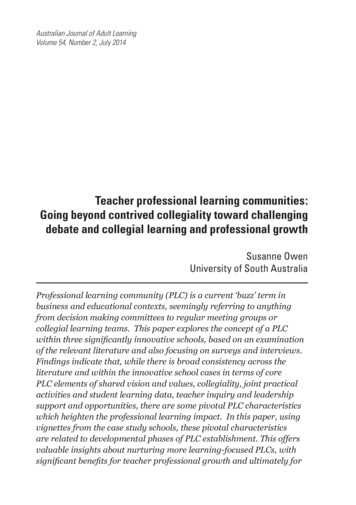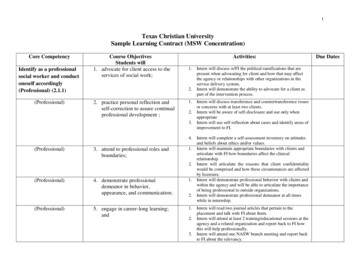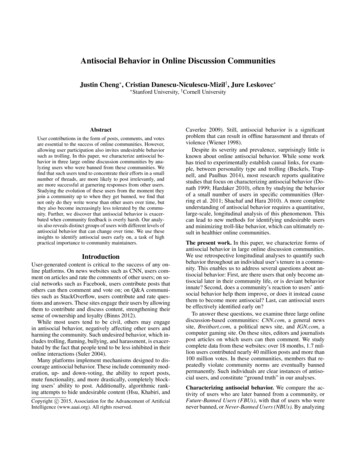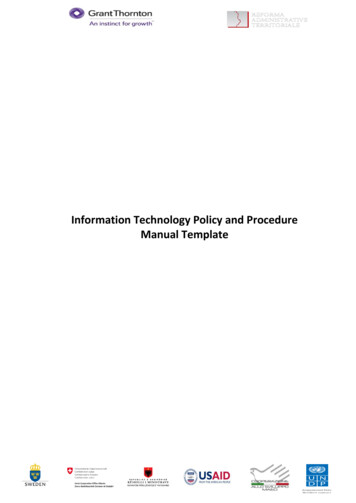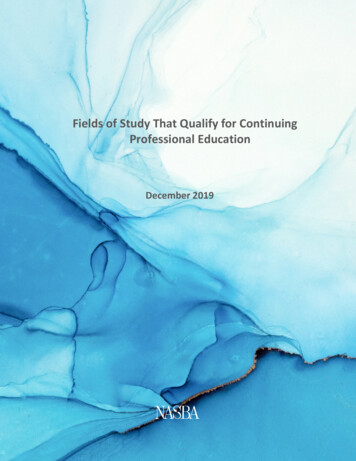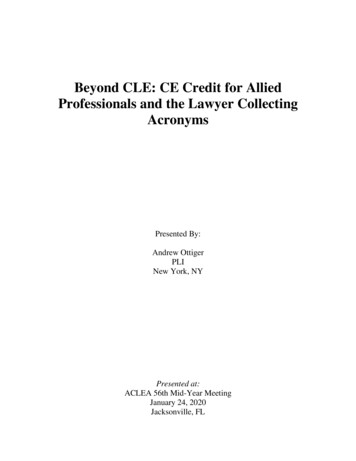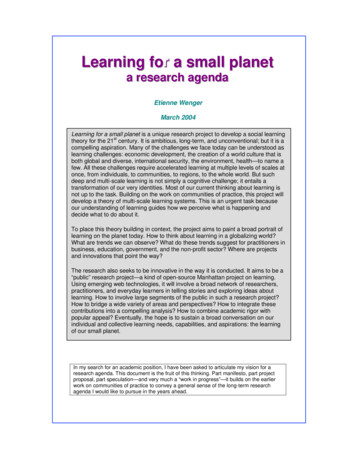
Transcription
Professional Learning Communities GuidanceFor Collaboration TimeTeaching and Learning Branch
Professional Learning Communities GuidanceTable of ContentsIntroduction to Professional Learning Communities . 3What are PLCs . 3Developing a Culture of Collaboration . 4Expectations and Work of Professional Learning Communities . 5DoDEA Expectations . 5Teacher Voice and Engagement . 5Attributes of High-Performing PLCs . 7Stages of Collaboration for Professional Learning Communities. 9Stages of PLC Collaboration Process . 9Cycle of PLC Stages of Collaboration with Roles and Responsibilities. 10Stage 1: Launching the PLC Work: Establish a Sense of Urgency . 11Stage 2: Analyzing Data and Setting Targets . 14Stage 3: Developing Focus and a Process for Monitoring Progress . 16Stage 4: Building and Sharing Standards-Based Lessons . 16Stage 5: Implementing Collaboratively Designed Lessons and Monitoring progress . 19Stage 6: Celebrating Success and Reviewing Progress of PLC work . 22Appendix:. 22Research . 23PLC Guidance December 2016Page 2
Professional Learning Communities GuidanceIntroduction to Professional Learning CommunitiesThis Professional Learning Communities (PLCs) Guidance serves to support the Department ofDefense Education Activity (DoDEA) districts and schools in their development of PLCs.DoDEA recognizes the benefits and research that PLCs provide DoDEA schools and that PLCsare integral to support the College and Career Ready Standards (CCRS) implementation. Thebenefits of PLCs are: Student learning increases when teachers examine and improve their practice.Collaborative professional practice reduces isolation and promotes sharing with and learningfrom colleagues.The responsibility for every student’s learning is shared by all.A collective culture of collaboration fosters “a personal commitment to rigorous training[and] continuous striving for excellence” combined with a deep appreciation of and responseto evidence and feedback and a desire to improve and change (Vescio, Ross, & Adams, 2008p. 87; DuFour, R., & Fullan, M, 2013)Time allocated for PLCs is sacred to the work of the team and should not be used for any otherpurpose. This Guidance also serves as the means for professional development and resources tosupport the PLCs.What are PLCsIn a school with a high-functioning PLC, each staff member is committed to high levels oflearning for all students. In PLCs, collaborative teams: Work together interdependently to achieve common goals linked to the purpose of learningfor all students and staff;Promote a collaborative culture focused on shared leadership and responsibility for theschool climate;Are a key ingredient to foster a change in culture that would ultimately promote and sustainchange and close the achievement gap;Serve as the primary model for innovative best practices and curriculum and assessmentchanges;Support an aligned curriculum, promote vertical teaming, and promote greater teacherinteraction and collaboration;Reflect on learning, practices, and student results to improve teaching and student learning;Focus on continuous learning and professional growth; andBuild leadership capacity that will result in all students achieving at a high level.A PLC is a structured form of collaboration that focuses on making decisions that are groundedin evidence, accumulating and circulating knowledge and ideas, providing one another withPLC Guidance December 2016Page 3
Professional Learning Communities Guidancesupport that improves the effectiveness of teaching, and creating a culture that both increasesteachers’ confidence and encourages them to be more open to—and actively engaged in—aprocess of continuous improvement and change.Developing a Culture of CollaborationThe development of PLCs is characterized by a deepening culture of collaboration (Hargreaves& Fullan, 2012). Every educator is responsible for the development and continuity of acollaborative culture. The progressions of a PLC can be seen as a continuum, moving from aculture of isolation to one of highly effective collaborative decision making. The Stages ofCollaboration best practices (pg.5 and chart) support and guide the district, school and PLCteams in a continuum of growth. The following provide a view of how communities andlearning communities are different from and encompassed in becoming a PLC.CommunitiesWork occurs in continuing groups and relationships, with a commitmentand collective responsibility for a common education purpose and whereeducators improve practice for that purpose as well as caring about eachother’ s lives and dignity as professionals and unitiesThe process of improvement is heavily informed by professional learningand inquiry into students’ learning and effective principles of teachingand learning. Problems are addressed by everyone in the organization bymeans of learning to work through challenges instead of applying quickfixes. The elements of communities described above are included.Collaborative improvements and decisions are informed by but notdependent on scientific and statistical evidence. They are guided byexperienced collective judgment and pushed forward by challengingconversations about effective and ineffective practice. The elements ofcommunities and learning communities described above are included.PLC Guidance December 2016Page 4
Professional Learning Communities GuidanceExpectations and Work of Professional Learning CommunitiesTeams of teachers, staff, and administrators who work together on common goals for schoolimprovement comprise PLCs. High-achieving PLCs analyze gaps in student learning, developSMART (specific, measureable, achievable, realistic, and time-bound) goals, focus on studentlearning needs, and are measured by evidence of success. PLCs work together to seek out bestpractices, test them in the classroom, continuously improve processes, and focus on results.These routine practices (National Center for Literacy Education, Awsumb-Nelson, 2014, LOCIdata, pg. 19, February 2016) include: Co-creating lessons;Co-creating assessments; andAnalyzing student work.Based on these routine practices, teachers develop appropriate intervention or enrichmentstrategies to ensure greater achievement for all students.DoDEA ExpectationsMembers of PLCs adhere to a common set of agreements about how they will work together.The agreements of DoDEA’s PLCs are listed below. Our purpose will always be on improving student learning and achievement.We will focus on examining data from student work, instruction, assessments, and dilemmasof practice to improve our teaching craft.We will maximize professionalism and productivity by implementing team-buildingstructures, such as norms and agendas, and by using processes and protocols to structuredialogue in ways that build trust and are inclusive.We will ground our decisions and instructional changes in best-practice research.Teacher Voice and EngagementPLCs work best when they are developed based on how they provide the most benefits forstudent learning and student growth. Teachers may collaborate in cross-content subject areas,grade levels, or within like subject-matter content PLCs. Using norms and protocols, teachersco-plan units/lessons, co-develop assessments, and co-analyze student work to examine andimprove practices that result in student growth. Additional focus for PLC work comes throughusing essential questions, such as: What we want our students to know and be able to do;How will we know if students have learned;What will we do if student are not learning or already know the learning; andFocused questions fuel deeper discussions to support student learning.PLC Guidance December 2016Page 5
Professional Learning Communities GuidanceElementary, middle, and high schools structuretheir collaboration time within their masterschedules. School leaders, union or associationrepresentatives, and school faculty will providefeedback to the principal prior to the developmentof a master schedule for purposeful collaborationfocused on learning and results. Additionalconsideration needs to be given to accommodatesingleton content teachers. Leveragingtechnology to allow remote and singleton contentarea teachers opportunities to collaborate withtheir peers through virtual PLCs has to be part ofthe master schedule discussion.PLC Guidance December 2016Page 6
Professional Learning Communities GuidanceAttributes of High-Performing PLCs(adapted from Learning by Doing (2016))DoDEA’s PLCs are committed to continuous improvement and are characterized by thefollowing attributes:FOCUS ON LEARNINGRESULTSFOCUS ON SHAREDVISION AND VALUESSUPPORT AND FOCUSON SHAREDLEADERSHIPFOCUS ON A CULTUREOF COLLABORATIONENGAGE INCOLLECTIVE INQUIRYAND LEARNINGEXHIBIT MUTUALTRUST AND RESPECTPLC Guidance December 2016by identifying essential outcomes and systemically responding whenstudents do not meet their learning targets as they move toward thoseoutcomes. Such a process includes common formative assessments(monitoring tools), regular monitoring of student performance with theaid of a variety of data, and the development of effective, researchbased interventions.by developing a deep, shared commitment to the learning,development, and wellbeing of both students and the adults who workwith them. This requires a conscious process of alignment and a focuson what is possible. A shared vision should reflect the collectivebeliefs of all stakeholders within a school and should be expressed as aclear set of guiding principlesby adhering to a model in which all participants have an equal voiceand a responsibility for decision making related to improving teachingand learning. In this model, all stakeholder interests are balanced andall members are involved in developing, adopting, and observingground rules and protocols that clarify how team members will worktogether and fulfill their responsibilities. (Duhigg, Charles, 2016).in which all participants learn from one another, create momentum tofuel continuous improvement, and engage in discussions focused oncurriculum/product, instruction/delivery, and assessment/monitoringthat promote collective responsibility and accountability.by relentlessly questioning the status quo—seeking new methods,testing them, and then reflecting on results. The inquiry process buildsshared knowledge by clarifying the questions that the group explorestogether; building the capacity of each staff member to implementbeliefs, attitudes, strategies, and processes that will result in allstudents achieving at a high level; having time and space dedicated tocollaborative interactions among staff; and learning from each otherthrough peer observation to deepen their knowledge of content andinstructional practice for continuous growth.by honoring the expertise of others; building a sense of loyalty,commitment, and effectiveness necessary for shared decision makingand the establishment of collegiality; and creating an environment inwhich risk-taking is encouraged, supported, and reinforced.Page 7
Professional Learning Communities GuidanceThe mission of PLCs is to increase student achievement in all schools, eliminate achievementgaps, and increase teacher effectiveness. DoDEA Community Strategic Plan (Volume II SchoolYears 2013/14-2017/18) targets the strategic goals of:STUDENT EXCELLENCESCHOOL EXCELLENCEChallenge each student to maximize his or herpotential and to excel academically, socially,emotionally, and physically for life, college,and career readiness.Develop and sustain each school to be highperforming within an inclusive environment ofinnovation, collaboration, continuous renewal,and caring relationships.This PLC Guidance supports both the DoDEA Community Strategic Plan and the CCRSimplementation.PLC Guidance December 2016Page 8
Professional Learning Communities GuidanceStages of Collaboration for Professional Learning CommunitiesEstablishing and strengthening effective instructional teams is challenging work. For thatreason, this PLCs Guidance provides examples and a cycle to help inform the work of teachers,school leaders, and district leaders based on prevailing research on PLCs. The goal is tocollaboratively create guidance that it is framed in a manner that makes sense to those who areclosest to the work of structuring PLCs.This PLCs Guidance delineates one way that the work of structuring PLCs can be envisioned.The stages are a process that is not linear, but it is recursive. This vision unfolds in the six stagesas part of a modified cycle (see diagram below). Those who use this PLCs Guidance in the fieldare also encouraged to tailor it as they deem necessary to meet the specific needs of their district,schools and teachers.It is hoped that this PLCs Guidance is a useful framework for furthering the development ofPLCs system-wide, in service of providing high-quality learning opportunities for all studentsand ensuring that they are able to achieve at their highest potential. While the arrows indicate acyclical direction, the stages of collaboration are not linear, but they move forward, backwardor across, based on the work of the group.Stages of PLC Collaboration ProcessPLC Guidance December 2016Page 9
Professional Learning Communities GuidanceCycle of PLC Stages of Collaboration with Roles and Responsibilities(adapted from Massachusetts Department of Education PLC Guidance)Six stages guide the implementation of PLCs to support the development and implementation ofeffective high-quality PLCs. The guidance stages provide the best practices and what eachstage might look like.Districts and schools are responsible for providing more targeted guidance and professionallearning to support the development, implementation, and evaluation of PLCs. This PLCsGuidance provides PLCs’ best practices in order to juxtapose current practices against thesepractices to determine areas for continued growth. The same expectation for school PLCs arealso expected of the Centers for Instructional Leadership and for the district offices.The stages of collaboration, which are listed below, provide the suggested best practices by rolefor the PLC team, the principal and the leadership team, and the superintendent and districtleadership team.PLC Guidance December 2016Page 10
Professional Learning Communities GuidanceStage 1: Launching the PLC Work: Establish a Sense of UrgencyPurpose: To increase professional collaboration focused on instruction and student results ―Lay the FoundationPLC TeamActionsPrincipal and LeadershipTeam (LT) ActionsSuperintendent TeamActionsSampleEvidenceEstablish Vision and PurposeEstablish sense of urgency.Align school vision toexample of an effectivevision statement: Allstudents will achieveacademic growth and willgraduate with the skillsnecessary to succeed at thenext level withoutremediation in a safe, fair,and caring schoolcommunity.Select method ofmaintaining meetingminutes. Keep minutes and,based on timelineestablished by the principal,share minutes withleadershipCreate shared understandingof common goals for PLCwork. Goals indicatecommitment to improveinstruction and studentlearning throughcollaboration aroundcreating and implementingcommon standards-basedlessons with embeddedformative assessments,providing feedback, andmonitoring studentachievement.Lead discussion to instillPLCs use of data and casestudies from international,national, state, and locallevels. Format data in a waythat highlights urgent needfor improvement.Facilitate teamwork to alignschool and district visions,and to ensure that schoolvision meets criteria for aneffective vision.Communicate expectationfor LT to maintain meetingminutes and share them withkey leaders.Ensure that the principal,LT, and PLCs have systemsand structures (includingsample agendas, sampleschedules, and means ofobtaining assistance withscheduling) to improveinstruction and studentlearning. Utilize portions of regularmeetings with principals toestablish an administrativePLC/principals’ network.School vision that isstudent focused,measureable, andaligned to districtvision.Vision is communicatedto all stakeholders,verbally and postingTeam agendas, minutesthat reflect a sense ofurgency throughestablished targets,timelines, and deadlinesfor activities, and isfocused on the work.Provide mentoring tosupport implementation.Work with principal to alignShare school vision with full district plan/schoolplan/PLC workschool community oncestatement is approved.Establishing PLCs and Setting NormsProvide research andreadings that highlight theway PLCs work and theirpotential impact oninstruction. Establishcommon purpose for thework of PLCs.PLC Guidance December 2016Ensure that districtrepresentatives are inattendance at some of theprincipals’ meetings so thatthey can reinforce PLCgoals when they interfacewith faculty. Teachers can describegoal of PLCs and workof the team.Characteristics of PLCsare posted in meetingrooms.Page 11
Professional Learning Communities GuidancePLC TeamActionsUtilize PLC meeting timethat has been carved out byprincipal and LT.Principal and LeadershipTeam (LT) ActionsDesign master instructionalschedule (with feedbackfrom all staff) to provideadequate meeting time forPLCs.Set consistent “sacred” timefor PLC meeting sessions.(Note: one meeting perweek, minimum 45minutes.)Establish behavioral andprocedural norms. Setnorms to make the PLCwork in a non-threateningmanner and focus on studentimprovement. PLC assignsroles such as secretary andtimekeeper and determinemeans for collectingfeedback on the processLead initial meeting(s) tobuild capacity of PLCleaders who will eventuallyfacilitate.Ensure that PLC sets normsthat enable PLC work tounfold in a non-threateningenvironment. Ensure thatteam members know thatdata analysis done by PLC isfor the purpose of improvingstudent performance.Superintendent TeamActionsSet expectations for districtoffice to stay apprised offrequency of PLC meetingsand to help in settingperiodic agendas incollaboration withprincipals.SampleEvidence PLC schedules areposted in meeting roomsor online.Posted agendas (onlineor kept whereavailable).Use regular meetings withprincipals to allow schoolleaders to touch base withdistrict representatives(curriculum andInstructional SystemsSpecialists [ISSs]) atcompletion of key stages indevelopment of PLC.Use regular principalmeetings to provideopportunities for schoolleaders to confer withdistrict representatives onagendas for initial PLCmeetings Printed norms areposted in PLC meetingroom(s) and focus oncollaboration and oncommitment tocontinuousimprovement.Set agendas for firstmeeting. Collaboratively setagendas and move togradual release of the PLC.Regularly emphasize theimportance of PLC work.PLC Guidance December 2016Page 12
Professional Learning Communities GuidancePLC TeamActionsPrincipal and LeadershipTeam (LT) ActionsEstablish behavioral andprocedural norms. Setnorms to make the PLCwork in a non-threateningmanner and focus on studentimprovement. Assign rolessuch as secretary andtimekeeper and determinemeans for collectingfeedback on the process.Lead discussion oncharacteristics of highperforming teams and sharetext references on PLCs.Suggested Resources:The Wisdom of Teams; TheFive Dysfunctions of aTeam; Learning by Doing;and On Common GroundPLC Guidance December 2016Superintendent TeamActionsProvide research andsupport regarding highperforming teams toprincipals. Encouragedistrict representatives toreview suggested literature.SampleEvidence Based on theirunderstanding of PLCs,the team begins tofunction effectively. Forexample, they groundtheir work in data andstay focused on studentlearning.Page 13
Professional Learning Communities GuidanceStage 2: Analyzing Data and Setting TargetsPurpose: To develop a culture of data-based instructional decision-making/continuous evaluation ofprogress across the cycle of learning and working together ― Focus on ResultsPLC TeamActionsPrincipal and LeadershipTeam (LT) ActionsSuperintendent TeamsActionSampleEvidenceReview Current School-Wide Targets/Goals based on DataReview strengths and gapsin performance. Reviewschool-wide improvementtargets that will already havebeen set by the LT, andconfirm priority areas ofimprovement focus bylooking at data.Consider other grade-level,subjects and course data anddetermine correlationbetween data and the targetsset by the LT for students inthe aggregate and forsubgroups, as needed.Using data, establish targetsfor each grade, content area,and/or course, depending onschool configuration orneed.Express each target as a %and # of students targeted tomove between each of theproficiency levels.Lead the LT in settingschool-wide improvementtargets and preparing charts,graphs, and tables of data tobe used at PLC meetings.Ensure that PLCperformance targets arealigned with ContinuousSchool Improvement goals(not separate targets)Present approved schoolwide targets to PLCs.Facilitate timely datasharing between the districtand principal/LT. School-wideimprovement targets areset by LT, are confirmedby PLCs, and are postedin PLC meetingroom(s). List of grade-level orcourse targets areproduced for each gradeand subject(elementary/middle) orfor each course (highschool).PLC targets are set.Arrange for professionallearning on data analysis androot cause analysis to beprovided to key schoolleaders.Ensure that school-basedprofessionals have access todata analysis tools andtechnical assistance.Provide necessaryprofessional development indata analysis.Setting Grade-Level or Course TargetsReview each list of targetsto be certain that targetedpercentage/ numericincreases are sufficient tomake progress and arealigned with school-widetargets. (Non-tested subjectsare part of this process.)Provide data for gradelevels, subjects, and courses.Confirm these targets inlight of school-wide targetsset by LT. (SMART Goals)At regular principalmeetings, each principalshares PLC deliverables,including lists of targets.Ensure that the district hasclear expectations and acoordinated approach toadministrating pre- and posttests and other assessments,so that data is consistentacross classes/school Setting Classroom and Individual TargetsSet classroom targets.Teachers in PLCs set % and# targets (SMART) forindividual classrooms.Specialists such as contentcoaches, experts in languageacquisition and shelteringcontent for English languagelearners (ELLs), andLead review of each list oftargets to be certain thattargeted increases aresufficient for school to makeprogress to achieve schoolwide goals.PLC Guidance December 2016Arrange for districtrepresentatives to meetregularly with principal toconfirm that targets foraggregate, for grade levels,and for subgroups are inalignment, and to confirmthat all targets align withdistrict goals. Classroom targets areset.Page 14
Professional Learning Communities GuidancePLC TeamActionsPrincipal and LeadershipTeam (LT) Actionsspecial education teachersassist with target-setting.Targets align with grade,subject, course targets, andschool-wide targets.Coordinate integration ofspecialists and support staffinto PLC work.Set individual studentgrowth targets for student,using each student’s nameand particular performanceresults. Referenceclassroom targets as part ofprocess. Use GRADE, BAS,PSAT, SAT-9, district- orschool-designed pre- andpost-tests, end-of-unit tests,and/or other assessmentsdeemed appropriate.Review each list of targetsto be certain that targetedgains will result in school’sachievement.PLC Guidance December 2016Superintendent TeamsActionEnsure that there is a reviewof all targets—from schoolwide to individual studenttargets—for the purpose ofassessing needs at the schoollevel and making decisionsabout deployment ofresources and assistance.SampleEvidence Individual targets are setfor each student.Page 15
Professional Learning Communities GuidanceStage 3: Developing Focus and a Process for Monitoring ProgressPurpose: To identify skill, conceptual understanding, and problem solving gaps/needs and setappropriate targets ― Focus on ResultsPLC TeamActionsPrincipal and LeadershipTeam ActionsSuperintendent TeamsActionSampleEvidencePrioritizing Students’ Skill, Conceptual Understanding, and Problem Solving NeedsDetermine areas of greatestneed (gap between studentperformance andstandard[s]) in terms ofstudents’ skill development,conceptual understanding,and/or problem solving byundertaking item analysis.Identify standards/strandswith which students struggle(approximately three or fourareas of need by grade foreach content area).Use data to prioritize areasof need (gaps).Approve areas of greatestneed identified by PLCs.Consult with PLCs aboutorder in which teachers willaddress needs throughinstruction. Document andshare information withdistrict representatives andsuperintendent via writtenstatements of prioritizedneeds.Ensure that student supportservices (academicinterventions and socialsupport services) areconsidered.Ensure that districtrepresentatives stay apprisedof PLC discussions aboutstudent skill and knowledgeneeds and curricular andinstructional programs’ability to address thoseneeds.Needs assessments arecompleted and are sharedwith school-level colleaguesand other PLCs.Areas of greatest need areprioritized, and briefnarratives to justify theprioritization are prepared.Make certain that districtlevel curriculum directorsand content and supportspecialists use LT and PLCdata in curriculum andinstruction decisions.Arrange for review ofprincipal’s statements.Access key districtpersonnel who can assistwith addressing areas ofgreatest need.Planning to Address Individual NeedsEstablish a process formonitoring each student’sprogress. For example,create a folder or use as anexisting work folder todocument progress madeand services accessed toaddress identified needs.Ensure that teachersunderstand the benefit ofmonitoring individualstudent progress.Establish process forcharting and monitoringclass, grade, subject area,and course performance dataon monthly basis todetermine progress towardmeeting targets.PLC Guidance December 2016Facilitate development ofstudent performancemonitoring system. Providetraining and/orcommunications to fosterprincipals’ and teachers’understanding of the truebenefit of maintaining andusing a system formonitoring student progress.A process that has beendeveloped by teachersand/or the district andschool leaders exists to helpwith monitoring ofindividual student progress.Support mapping ofprogress through use oftechnology and provision ofdistrict-developed electronictemplates.Page 16
Professional Learning Communities GuidanceStage 4: Building and Sharing Standards-Based LessonsPurpose: To ensure that teachers have instructional resources necessary to address prioritized areas ofneed ― Learning is FundamentalPLC TeamActionsPrincipal and SharedLeadership Team ActionsSuperintendent TeamsActionSampleEvidenceReviewing Curriculum and Guidelines in Relation to NeedsReview standards-basedcurriculum to identify whereessential learning standardsare tied to areas of greatestneed. Determine how needsare addressed across contentareas.Advocate for any necessaryadjustments to curriculum,pacing guides, andinstructional materials thatare highlighted through PLCwork.Review curriculum map andpacing guides to determinewhen areas of greatest need(performance gaps) areaddressed. Align plannedactivities and needs.Ensure that standards-basedcurriculum maps are inplace, are aligned withDoDEA CurriculumFrameworks, and arereviewed as part ofcurriculum renewal cycle foreach content area. Districtprovided resources shouldinclude performancestandards, suggestions aboutstudent work thatdemonstrates proficiency,and materials to addressneeds of all students.Alignments between areasof greatest need and gradelevel subject or coursecurricula are completed.This includes documentationof identified needs matchedwith appropriate resources.Facilitate process foraligning needs andresources.Establishing Performance Measures and Engaging in Formative AssessmentCommit to strategies forformatively assessingstudents.Identify type(s) of work thatstudents will produce asevidence of proficiency,including ways (forexample, standards-basedrubrics) that work will beassessed to gauge quality.Provide professionallearning on building andimplementing commonformative assessments.Ensure that d
Collaboration best practices (pg.5 and chart) support and guide the district, school and PLC teams in a continuum of growth. The following provide a view of how communities and learning communities are different from and encompassed in becoming a PLC. Communities Work occurs
